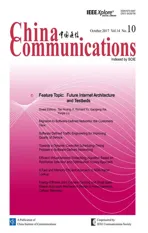An SNR-Adaptive Relaying Algorithm for Multi-Antenna Cooperative Networks
2017-04-08ShuangshuangHan,PengZhang,FeijinShi等
I. INTRODUCTION
Nowadays, multiple-input multiple-output(MIMO) technique has spurred considerable research attention because of its characteristics of combating wireless fading and link throughput improvement by the help of exploiting multiple transmit and receive antennas [1].However, it might be not easy for its practical implementation because of the limitation of power consumption and hardware physical performance & size. Therefore, cooperative communication has been a promising paradigm for higher spatial diversity by enabling cooperative relay nodes to share their antennas and derive a virtual MIMO array [2]. In recent years, cooperative communication has been one of the research hotspots of mobile communication technology. Both MIMO technique and cooperative communications have been considered as the key technologies of 5G networks [3]-[10]. In particular, as one typical application, cooperative vehicular ad hoc networks (VANETs) have been widely recognized as a promising technique for its application in future intelligent transportation systems[9], [11]. The quality of traffic conditions and road congestion would be improved based on vehicle-to-vehicle and vehicle-to-infrastructure cooperative communications [12], [13].Therefore, MIMO and cooperative techniques would be greatly helpful for the development of Internet of Things, e.g., Internet of Vehicles.
In cooperative communications, independent paths between the source and the cooperative relay nodes are generated by the relay channels. The relay channels could be considered as an auxiliary paths for the direct communications between the source and the destination. One of the key aspects for cooperative communication is the process of the received signal at the cooperative relay nodes.There are two conventional processing protocols, called amplify-and-forward (AF) and decode-and-forward (DF) relaying protocols. For the first one, the cooperative relay nodes simply amplify and retransmit the received signal to the destination. While for the latter one, the process at the cooperative relay nodes is to decode the received signal, and then re-encode and transmit it to the destination.
The above two relaying protocols are both fixed relaying, which have their own advantages. AF relaying performs better than DF relaying for low signal-to-noise ratio (SNR)region, while DF relaying outperforms AF relaying for high SNR region. However, the switching between these two relaying protocols leads to extra cost for its practical implementation. Therefore, in order to jointly exploit the advantages of both AF and DF,adaptive relaying protocols have been the research interest [13]-[19]. These papers focused on single-antenna relay strategies. However,the extension to multi-antennas relay networks is not straightforward [20], [21]. Therefore, in this paper, an SNR-adaptive forward (SAF)relaying scheme is proposed to overcome the problem of AF and DF for multi-antenna cooperative networks.
The main idea of the proposed SAF relaying scheme is to adaptively process the received signal based on the known channel state information SNR (or can be perfectly-estimated [22]). The linear minimum mean square error (LMMSE) and maximum-likelihood (ML) detection results are jointly considered in our schemeThe parameter ω could be derived by the probability of the true transmitted signal within a hypersphere list L [23]. Based the theoretical analysis and simulation results, the performance and the advantages of the proposed SAF relaying scheme are approved and confi rmed.
In order to to achieve the advantages of both AF and DF,an SNR-adaptive forward relaying algorithm is proposed in this paper for multi-antenna cooperative networks.
The rest of this paper is organized as follows. Section II describes the system model and two conventional relaying protocols. The SAF relay scheme is proposed and demonstrated in Section III, followed by the theoretical analysis in Section IV. The simulation results are given in Section V. Finally, Section VI concludes this paper.
II. SYSTEM MODEL
As shown in Figure 1, the cooperative network model in this paper is given, where the source node is equipped with SNttransmit antennas,all the cooperative nodes have RNttransmit antennas and RNrreceive antennas, and the destination node is equipped with DNrreceive antennas. In this system model, the signals are transmitted from the source node to the destination node via one or several cooperative relay nodes. It is assumed that NRrelays receive the transmitted signal from the source node; thus, the received signal riat the i-th(i=1,2,…,NR) relay is derived by
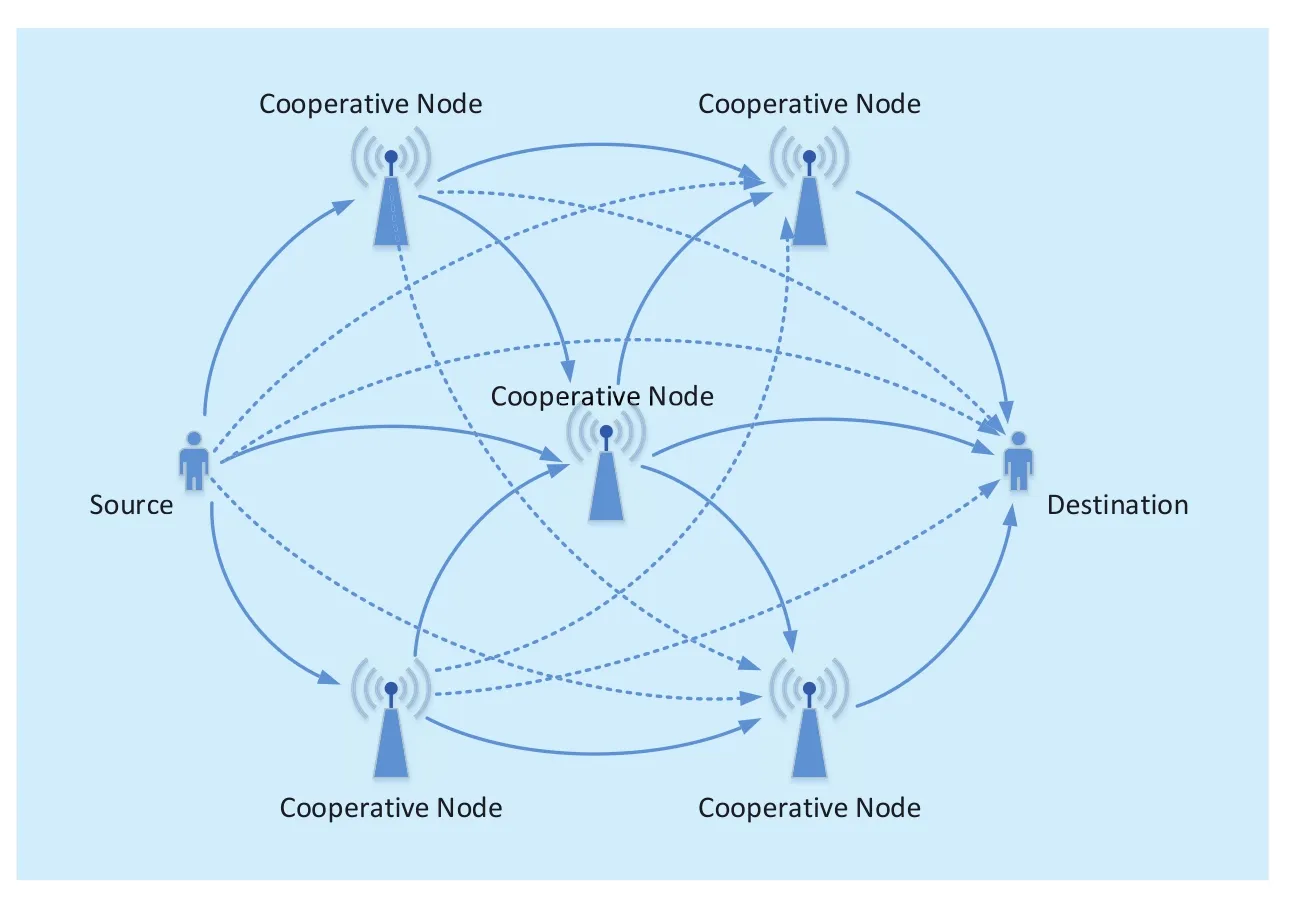
Fig.1 A system model of cooperative communication

In this paper, assuming memoryless cooperative relays, the relays receive the signal from the source node, process and re-transmit the processed signal to the destination node. Here,the relay function denoted by F()r is derived based on the current received signal r only.The average transmitted power at the cooperative relay node is Pr; thus, E‖‖[()]Fr2=Prshould be satisfied. Therefore, if NRrelays retransmit the processed signals to the destination node, the received signal would be derived as
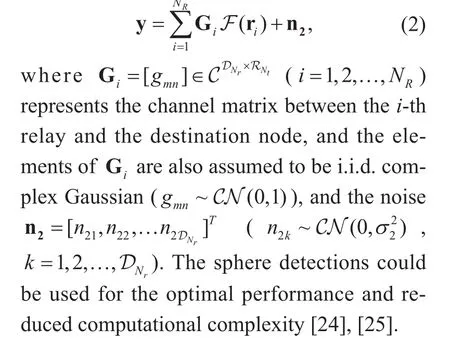
As known, the performance of cooperative relay networks critically relies on the relay function, because the reliability of the relayed information plays an important rule on the performance of the relay networks. There are two main conventional relay functions, i.e.,AF and DF schemes. Therefore, these two relay scheme would be discussed next.
2.1 Amplify-and-forward
For AF scheme, intermediate cooperative relay nodes only forward the scaled version of the information received from the transmitted node. Surprisingly, such a simple method turns out to be optimal in some particular communication scenarios. Further, AF requires much less delay because of its simple processing at the cooperative relay nodes. Also, it needs much less computing power as no detection/decoding operations are performed at the cooperative relay nodes. However, the performance of AF scheme would be significantly reduced for high SNR region, because the noise is also amplified.
The relay function of AF scheme is given as

where β is the amplifying factor to satisfy the power constraint of the cooperative relay node.
2.2 Decode-and-forward
In DF scheme, the cooperative relay nodes firstly decode the received signal from the transmitter and transmit the re-encoded information to the next cooperative node or to the destination. Thus, the relay function of DF scheme is given as

where Q denotes the constellation set and SNtis the number of transmitted antenna at the source node.
Although the detection/decoding process at the cooperative relay nodes obtains performance improvement, the computational complexity of the DF scheme is much higher than the AF scheme. The reason is that the DF relay scheme firstly decodes the received signal and re-encodes it, and then retransmits it to the destination. This leads to high computational complexity. Besides, it has been confirmed that the performance of the DF scheme is worse than the AF scheme in low SNR region,because the error detection would be propagated to the destination once the detection is wrong at the cooperative relay nodes.
As demonstrated above, by jointly considering the advantages and disadvantages of AF and DF, the main idea of this paper is to propose a relaying method achieving the optimal performance for the whole SNR region,called SNR-adaptive forward (SAF) relaying scheme.
III. SNR-ADAPTIVE FORWARD ALGORITHM
In this paper, the channel state information is assumed to be known at the cooperative relays and the destination node. Since identical relays are assumed not to cooperate for multiple relays networks, single-relay network is considered for analysis. Therefore, for simplify, H and G denote the source-relay and relay-destination channels substituting Hiand Giin Eq. (1) and Eq. (2), respectively.
From the discussion of the conventional AF and DF relay methods in Section II, it is derived that AF performs better than DF in low SNR region while it is opposite for high SNR region. Consequently, an SNR-adaptive forwarding (SAF) is proposed in this paper,which obtains the advantages of both AF and DF for the whole SNR region with no need of switching between these two traditional relaying methods.
3.1 SNR-adaptive forward
This section introduces the proposed SAF relaying scheme. As described in Section II, the signal received at cooperative relay node R is derived by

where s is the transmitted signal at the source node, n is AWGN with mean 0 and variance σ2, and H is the channel matrix. Therefore,the unconstrained MMSE estimate of the transmitted signal at the relay is

where Q is the constellation, N is the number of transmitted antennas. Here, with the assumption of the equal priori probabilities for transmitted symbols, then, it is given as

Because of the AWGN,
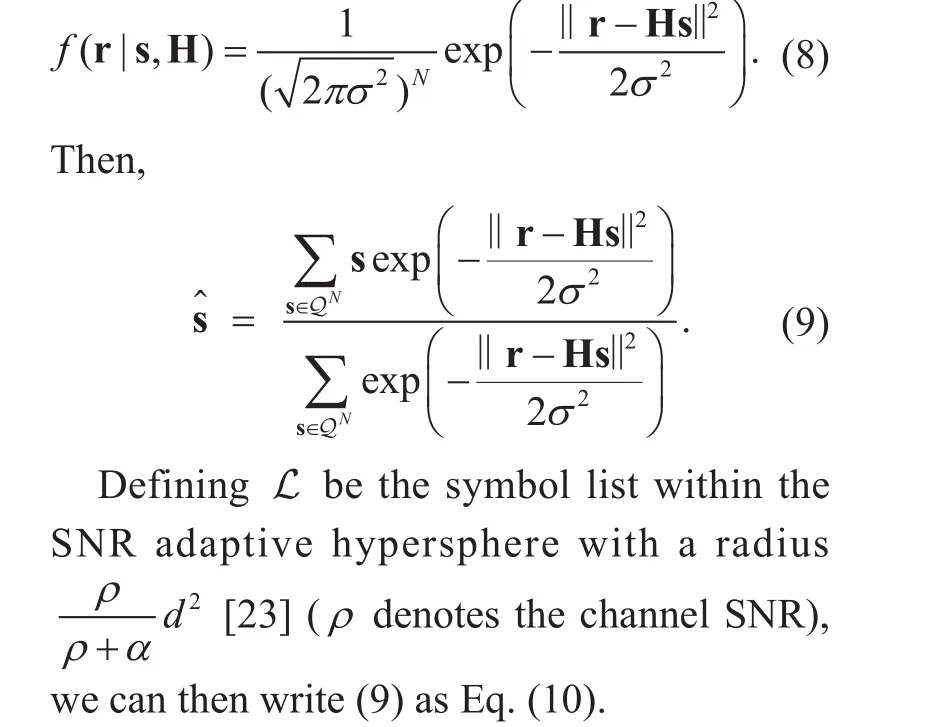
The second term in (10) can be computed using list sphere decoder while the first term in (10) can be approximated using an integral
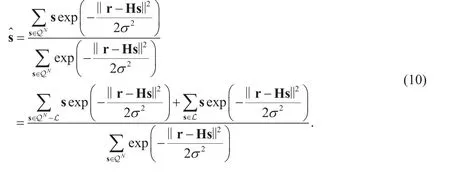
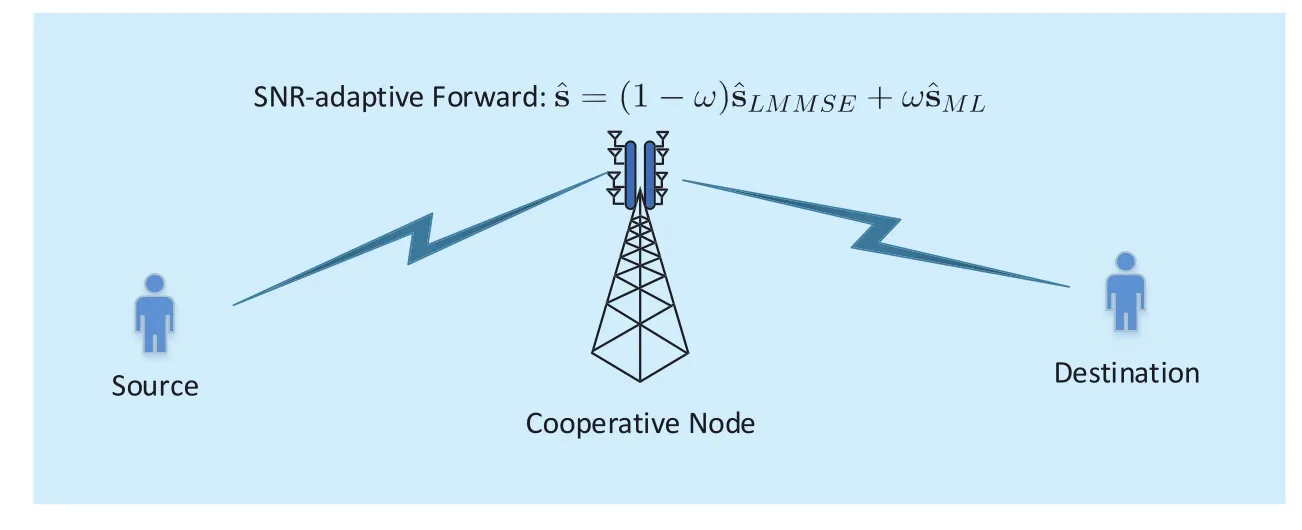
Fig. 2 SNR-adaptive forward algorithm

where the integration is over (,)−∞∞, but it is needed to remove the elements in the list L.For example, in the one dimension case, if a is in L, the integral will be

where η denotes a parameter with a very small value. However, for high dimension systems, computing (12) directly is difficult.Therefore, our idea to approximate (9) is as follows.
If L is empty, (10) could be approximated to be
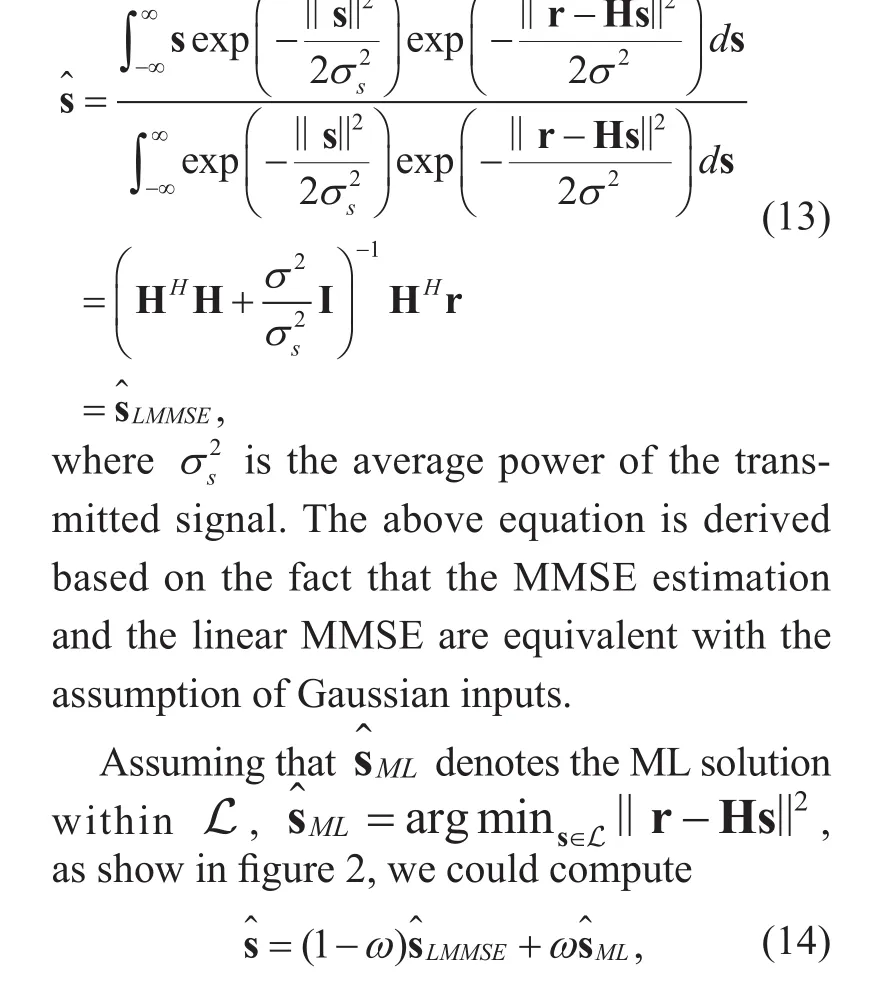
which is the definition of the proposed SAF algorithm. This definition aims to sufficiently use the advantages of both LMMSE and ML solution achieving the optimal performance over AF and DF.
In Eq. (14), ω plays an important role in this algorithm. Thus, in the following section,the derivation of this parameter would be analyzed.
IV. THEORETICAL ANALYSIS
In this section, the theoretical analysis of the proposed SAF relay scheme is derived. One derivation of the parameter ω in Eq. (14) is given in the following. Then, the mean square error (MSE) of the proposed SAF scheme is analyzed to approve its advantages compared to the conventional AF and DF.
4.1 Approximation of parameter ω
One method to derive the parameter ω in Eq.(14) is to use the probability that the true solution of s^ is within the hypersphere set L, i.e.ω=∈Pr()sL. In low SNRs, it is better to choose a small radius for L as the LMMSE solution is preferred while it is better to use the ML solution in high SNRs. Thus, Eq. (14)becomes
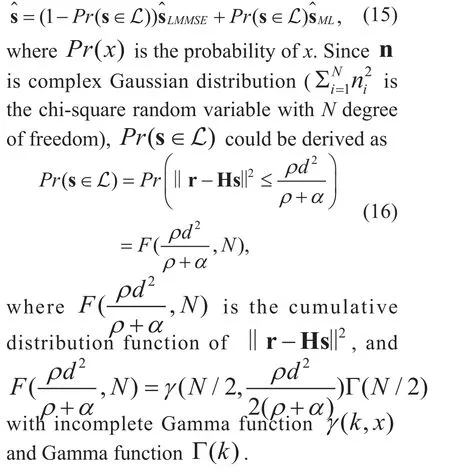
4.2 MSE analysis

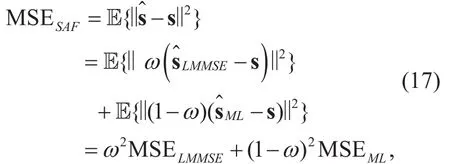
LMMSE estimation and ML detection can be
The MSE of derived by the following formulas Eq. (18)and (19).

To demonstrate the MSE performance, figure 3 provides an example of the theoretical results of the proposed SAF, conventional AF and DF for a 22× BPSK cooperative network. It is clearly shown that the proposed SAF achieves the optimal MSE within the whole SNR region. Above all, due to its smallest MSE, the SAF relay is expected to yield an optimal performance at the destination node.This would be confi rmed in the next section.
V. SIMULATION RESULTS AND DISCUSSIONS
This section shows the performance comparison of the proposed SAF relaying scheme with the conventional AF and DF for several types of relay networks, measured by symbol error rate (SER). The transmit power at the source node and the cooperative relays are assumed to be equal. At the destination, sphere detection is exploited for optimal performance and low computational complexity.

Fig. 3 MSE comparison of relay functions at different SNRs for 2×2 BPSK system
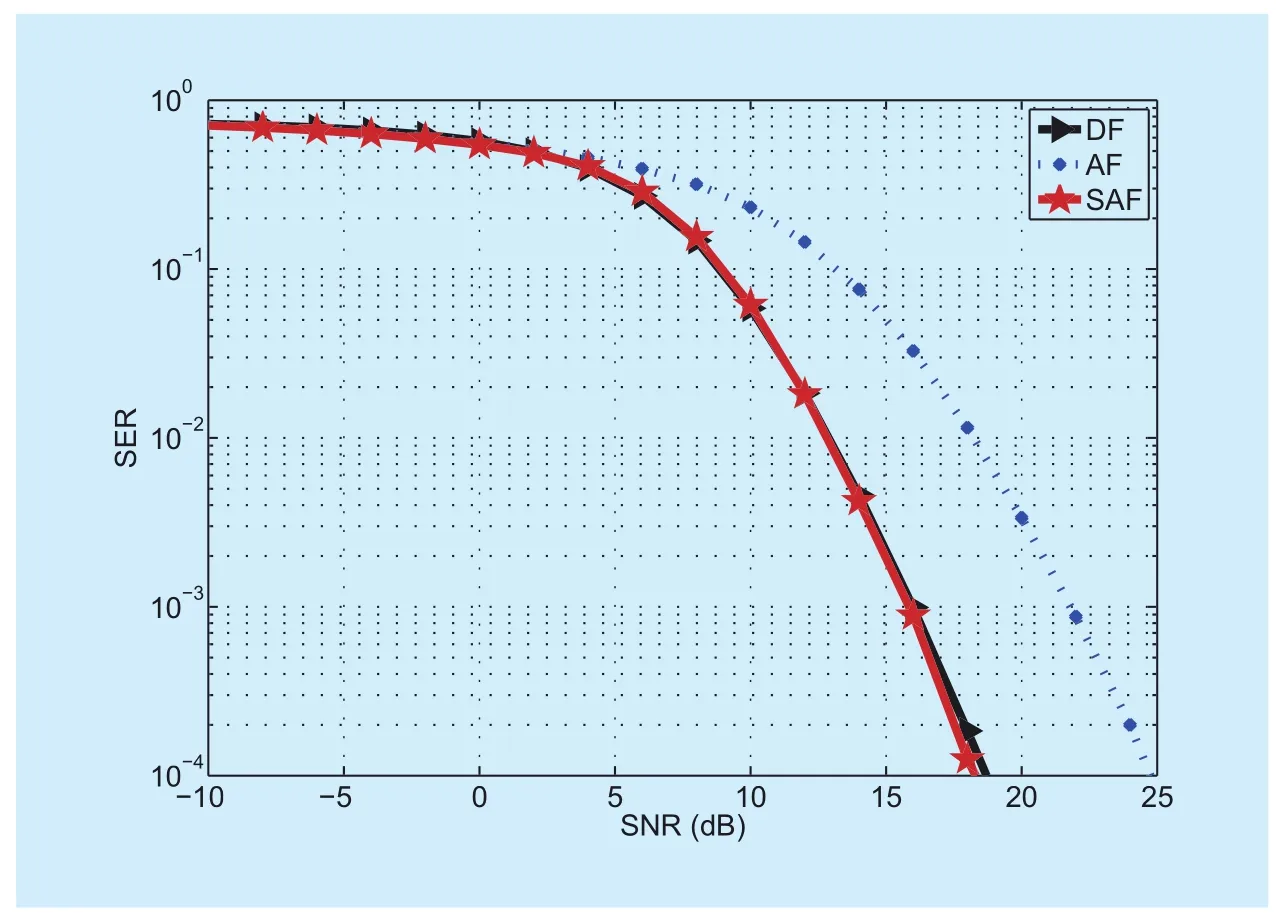
Fig. 4 SER comparison of relaying methods for MIMO relay network with=4 and 4-QAM

Firstly, figure 4 gives the SER performance comparison of different relaying schemes for a 44× 4-QAM multi-antenna cooperative network with one relay path. As analyzed in Sec-tion IV, the proposed SAF outperforms AF and DF. For low SNR region, the proposed SAF performs similar to AF, while it achieves a similar SER performance to DF for high SNR region. Besides, the SAF achieves 7dB performance gain at an SER=10-4compared to the traditional AF. Therefore, as aforementioned,the proposed SAF achieves the optimal SER performance compared to the conventional AF and DF. Besides, in order to sufficiently approve the advantages, the proposed SAF would be extended for different types of relay networks in the following.
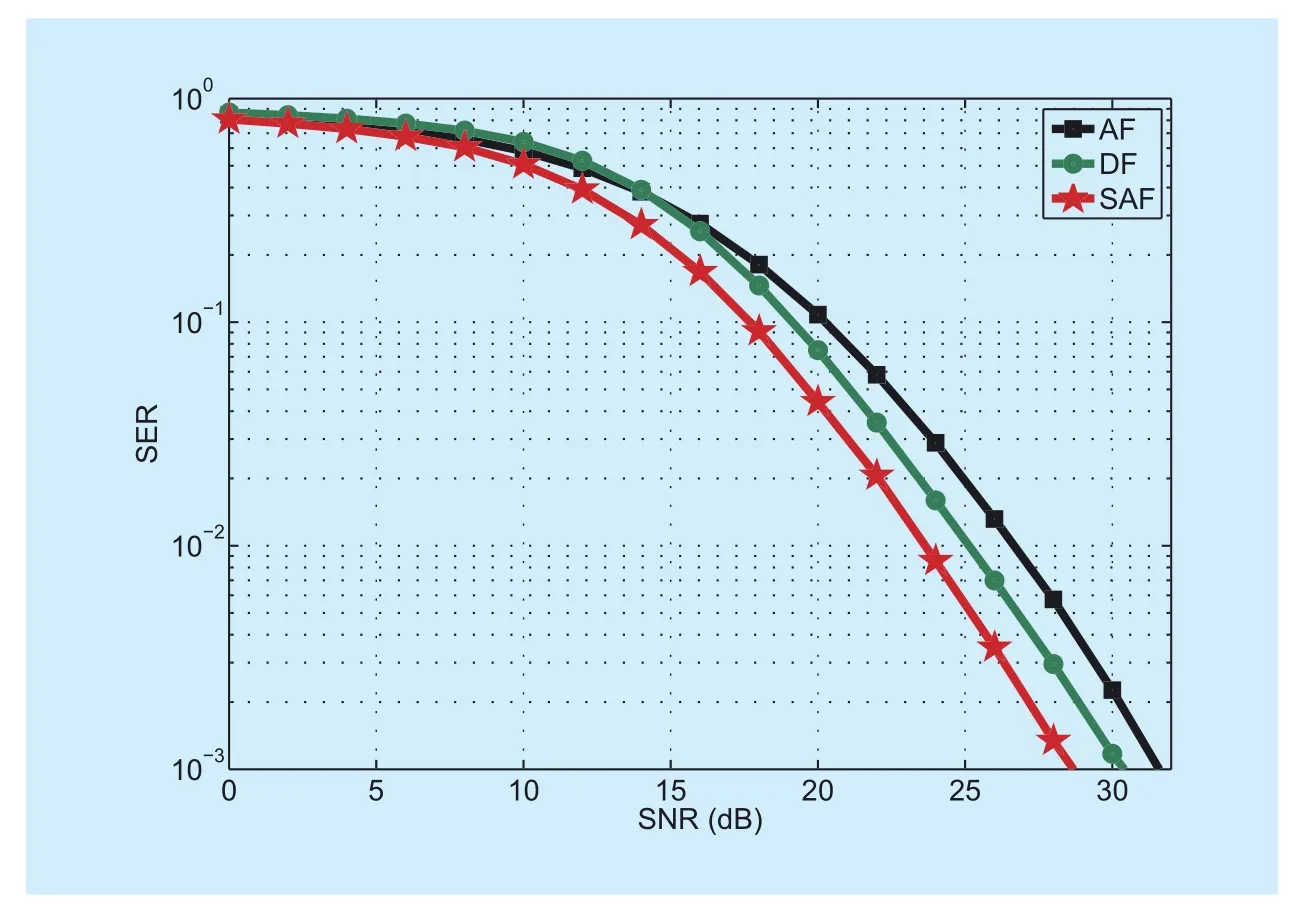
Fig. 5 SER comparison of relaying methods for a two parallel MIMO relay network with SNt =RNr =RNt =DNr=2 and 16-QAM
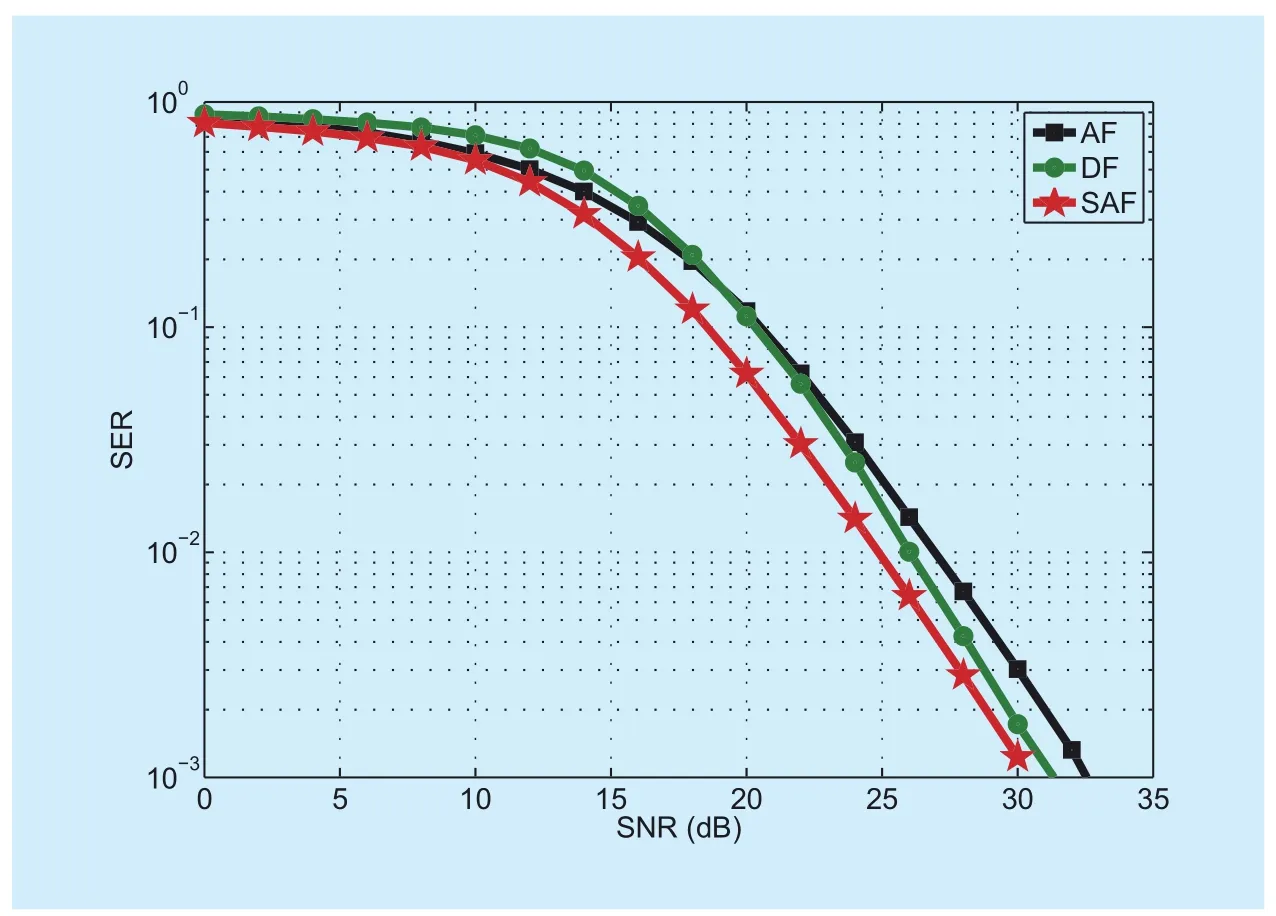
Fig. 6 SER comparison of relaying methods for a three parallel MIMO relay network with =2 and 16-QAM, where one of the path is assumed to have two hop relay nodes
The advantages of multi-antenna single relay network have been shown in figure 4,but the extension to parallel multiple relay networks is straightforward and also examined here. Figure 5 shows the simulation results for a cooperative network with two parallel cooperative relay nodes and 22× 16-QAM. It is clearly found that there is a clear performance intersection between AF and DF, i.e., AF outperforms DF when SNR≤14dB, while DF performs better than AF when SNR≥14dB.As analyzed in Section IV, the proposed SAF achieves better performance than both AF and DF. Note that the proposed SAF gains 4dB and 2dB over the AF and DF, respectively. It is clearly demonstrated that reliable information at the cooperative relays helps to obtain performance gains compared to the AF and DF for parallel relay networks, and this advantages would be expected to be enhanced with the increasing number of cooperative relay nodes.
In order to further approve the benefits of the proposed SAF, the SER performance is also evaluated for a hybrid relay network(collaborative relaying scenario). Figure 6 demonstrates the SER performance of the proposed SAF relaying for parallel networks with three paths, where the first two paths are with 1 cooperative relay node and the last path is with 2 serial cooperative relay nodes (22×16-QAM). Clearly, as expected, as shown in figure 6, the proposed SAF gains 2.5dB and 1dB performance improvements over AF and DF at an SER of 10-3, respectively. Besides,AF outperforms DF in the low SNR region(SNR≤19dB), while the reverse is correct for high SNR region (SNR≥19dB). However, the proposed SAF relaying scheme always performs better than AF and DF for the whole SNR region.
The above simulation results and discussions show that the proposed SAF relay scheme outperforms AF and DF for all SNRs in cooperative relay networks. Besides, the performance gain is expected to be increased with increasing number of parallel cooperative relay nodes.Furthermore, another benefit of SAF is a unified algorithm without switching algorithm between AF and DF for different SNRs.
VI. CONCLUSION
For multi-antenna cooperative networks, this paper proposed an SNR-adaptive forward relaying algorithm to achieve the advantages of both AF and DF. To approve the performance of the proposed SAF, its MSE characteristics at the relay was analyzed, demonstrating its minimum MSE compared to that of the conventional AF and DF in the whole SNR region.It was also found that the proposed SAF relaying scheme performs similar to AF and DF for the low SNR and high SNR regions. Besides,it does not need a switching algorithm, which is easy for practical implementation. Furthermore, for multiple parallel cooperative relay networks, the performance improvement of the proposed SAF over AF and DF is expected to be increased with the increasing number of cooperative relay nodes. The simulation results further approved the advantages of the proposed SAF relaying algorithm.
ACKNOWLEDGMENT
This work was supported in part by the National Natural Science Foundation of China 61501461, 61471269, 71232006, and 61533019; and the Early Career Development Award of SKLMCCS (Y3S9021F34).
Reference
[1] E. Biglieri, R. Calderbank, A. Constantinides,A. Goldsmith, A. Paulraj, and H. V. Poor, MIMO Wireless Communications. New York, NY, USA:Cambridge University Press, 2007.
[2] A. Nosratinia, T. Hunter, and A. Hedayat, “Cooperative communication in wireless networks,”IEEE Commun. Mag., vol. 42, no. 10, pp. 74-80,Oct. 2004.
[3] Y. Fan and J. Thompson, “MIMO configurations for relay channels: Theory and practice,” IEEE Trans. Wireless Commun., vol. 6, no. 5, pp. 1774–1786, May 2007.
[4] L. Zhou, “QoE-Driven delay announcement for cloud mobile media,” IEEE Trans. Circuits and Syst. for Video Technol., vol. 27, no. 1, pp. 84–94,Jan. 2017.
[5] Z. Zhang, X. Wang, K. Long, A. Vasilakos, and L. Hanzo, “Large-scale MIMO-based wireless backhaul in 5G networks,” IEEE Wireless Commun., vol. 22, no. 5, pp. 58–66, Oct. 2015.
[6] H. Xie, F. Gao, and S. Jin, “An overview of lowrank channel estimation for massive MIMO systems,” IEEE Access, vol. 4, pp. 7313–7321, 2016.
[7] H. Xie, F. Gao, S. Zhang, and S. Jin, “A unified transmission strategy for TDD/FDD massive MIMO systems with spatial basis expansion model,” IEEE Trans. Veh. Technol., vol. PP, no. 99,pp. 1–1, 2016.
[8] L. Zhou, “Mobile Device-to-Device video distribution: Theory and application,” ACM Trans.Multimedia Comput. Commun. Appl., vol. 12, no.3, pp. 38:1–38:23, Mar. 2016.
[9] F.-Y. Wang, L. Yang, X. Cheng, S. Han, and J. Yang,“Network softwarization and parallel networks:beyond software-defined networks,” IEEE Network, vol. 30, no. 4, pp. 60–65, July 2016.
[10] F.-Y. Wang, L. Yang, X. Hu, X. Cheng, S. Han, and J.Yang, “Parallel networks and network softwarization: a novel network architecture (in chinese),”Sci Sin Inform, vol. 47, pp. 1–21, 2017.
[11] L. Li, Y. Lin, N. Zheng, and F.-Y. Wang, “Parallel learning: a perspective and a framework,” IEEE/CAA Journal of Automatica Sinica, vol. 4, no. 3,pp. 389–395, 2017.
[12] R. Atallah, M. Khabbaz, and C. Assi, “Multi-hop vehicle-to-infrastructure communications: A feasibility study, modelling and performance analysis,” IEEE Trans. Veh. Technol., vol. PP, no. 99,pp. 1–1, 2016.
[13] Y. Zhu, L. Song, S. Wu, H. Wang, and C. Wang,“Cooperative stepwise relaying and combining for multihop vehicular wireless communication,”IEEE Trans. Veh. Technol., vol. 64, no. 6, pp. 2663–2671, June 2015.
[14] E. Basar, U. Aygolu, E. Panayirci, and H. V. Poor, “A reliable successive relaying protocol,” IEEE Trans.Commun., vol. 62, no. 5, pp. 1431–1443, May 2014.
[15] S. M. Azimi-Abarghouyi, M. Hejazi, B. Makki, M.Nasiri-Kenari, and T. Svensson, “Decentralized compute-and-forward for Ad Hoc networks,”IEEE Wireless Commun. Lett., vol. 5, no. 6, pp.652–655, Dec 2016.
[16] W. Li and J. Lilleberg, “Optimized discreteestimate-and-forward relaying strategy,” in Proc.IEEE Wireless Communications and Networking Conference (WCNC), Apr. 2012, pp. 963-967.
[17] A. Chakrabarti, A. Sabharwal, and B. Aazhang,“Practical quantizer design for half-duplex estimate-and-forward relaying,” IEEE Trans. Commun., vol. 59, no. 1, pp. 74-83, Jan. 2011.
[18] S. Tian, Y. Li, and B. Vucetic, “Piecewise-and-forward relaying in wireless relay networks,” IEEE Signal Process. Lett.,, vol. 18, no. 5, pp. 323-326,May 2011.
[19] P. Weitkemper and G. Dietl, “Maximum likelihood receiver for MMSE relaying,” in Proc. of IEEE ICC,(ICC), Jun. 2011, pp. 1-5.
[20] S. Han, P. Zhang, F. Shi, and F. Y. Wang, “Relaying strategy based on estimated information for multi-antenna cooperative networks,” China Commun., vol. 14, no. 8, pp. 157–165, Jul. 2017.
[21] S. Han, X. Cheng, and L. Yang, “A novel forwarding method for full-duplex two-way relay networks,” China Commun., vol. 14, no. 4, pp.65–72, Apr. 2017.
[22] G. Wang, Q. Liu, R. He, F. Gao, and C. Tellambura, “Acquisition of channel state information in heterogeneous cloud radio access networks:challenges and research directions,” IEEE Wireless Commun., vol. 22, no. 3, pp. 100–107, Jun. 2015.
[23] S. Han and C. Tellambura, “A complexity-efficient sphere decoder for MIMO systems,” in Proc.IEEE Int. Conf. on Commun. (ICC), Jun. 2011, pp.1-5.
[24] M. Damen, H. El Gamal, and G. Caire, “On maximum-likelihood detection and the search for the closest lattice point,” IEEE Trans. Inf. Theory,vol. 49, no. 10, pp. 2389-2402, Oct. 2003.
[25] S. Han, T. Cui, and C. Tellambura, “Improved K-best sphere detection for uncoded and coded MIMO systems,” IEEE Wireless Commun. Lett.,vol. 1, no. 5, pp. 472-475, Oct. 2012.
杂志排行
China Communications的其它文章
- Migration to Software-Defined Networks: the Customers’ View
- Software Defined Traffic Engineering for Improving Quality of Service
- Towards a Dynamic Controller Scheduling-Timing Problem in Software-Defined Networking
- Efficient Virtual Network Embedding Algorithm Based on Restrictive Selection and Optimization Theory Approach
- A Fast and Memory-Efficient Approach to NDN Name Lookup
- Energy-Efficient Joint Content Caching and Small Base Station Activation Mechanism Design in Heterogeneous Cellular Networks
